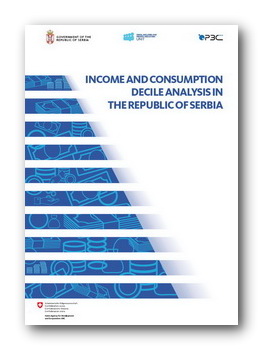 The Social Inclusion and Poverty Reduction Unit of the Government of the Republic of Serbia has carried out an analysis of the decile distribution of consumption and income in Serbia for the period 2006-2017. A particular focus of the analysis was aimed at the status of the poorest decile of the population.
The Social Inclusion and Poverty Reduction Unit of the Government of the Republic of Serbia has carried out an analysis of the decile distribution of consumption and income in Serbia for the period 2006-2017. A particular focus of the analysis was aimed at the status of the poorest decile of the population.
A decile analysis is a procedure whereby the equivalent consumption, and/or income of all households or individuals are ranked from lowest to highest. The ranked households and individuals are divided into ten equal groups, so that the first decile contains those with the lowest equivalent consumption/income (poorest households), while the tenth holds the highest (richest households). The deciles divide the total population into ten equal parts, and depending on whether equivalent consumption or income are being reviewed, an appropriate equivalence scale is used.
The analysis shows that the average consumption of the first, poorest decile in 2017 was RSD 11,161 per consumer unit, while the average consumption of the tenth, richest decile was around five and a half times higher. During the 2006-2017 period the nominal average consumption of the population increased on average 2.1 times, with the highest increase by the first decile (2.3 times).
The structure of expenditures for personal consumption differs significantly. The share of consumption of food and non-alcoholic beverages comprises nearly half the expenditures of the first decile and is nearly twice that of the tenth. The share of consumption for education is seven times lower for the poorest compared to the richest.
The average income for the first decile in 2017 was RSD 9,411 person consumer unit, while for the tenth decile it was almost eight times higher. Salaries and pensions represent the main source of income for the population of the Republic of Serbia, with this income comprising over 85% of all income sources in 2017. However, there are significant differences across the deciles. Pensions are the main source of income for the poorest decile, and comprise 38.7% of the total income. This finding indicates that the first decile consists of households with a very low labour intensity, but high dependence on other income, with the dominant role played by social transfers.
Regarding the distribution of income by decile, the analysis has shown that the poorer deciles participate with a significantly lower share in the distribution of total income compared to the richer ones. In Serbia, 10% of the poorest population participates with merely 3.1% in the total income, while the 10% of the richest population produced as much as 20% of the total income.
The data accompanying this publication is fully available at: “Income and Consumption Decile Analysis in the Republic of Serbia 2006-2017 – aggregate data” (.xlsx)
 Government of the Republic of Serbia
Government of the Republic of Serbia















 pdf [271 KB]
pdf [271 KB]
Leave a Comment